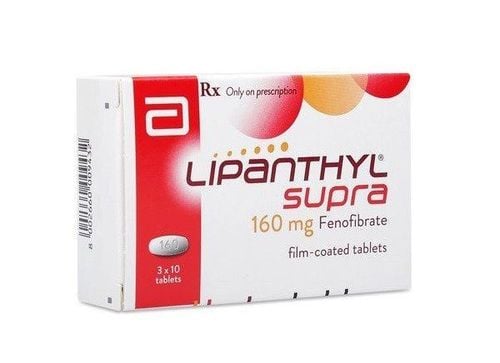This is an automatically translated article.
Fenofibrate has an effective effect on reducing blood lipid levels, especially triglycerides. This active ingredient is in the drug Stanlip. So what is the use of Stanlip and how should it be used?
1. What is Stanlip?
Stanlip has the main active ingredient fenofibrate 160mg. Stanlip is a product of Ranbaxy Laboratories., Ltd (India), circulated in Vietnam with the registration number VN-8272-04.
Stanlip is in the form of film-coated tablets, packed in a box of 10 blisters x 10 tablets. The active ingredient Fenofibrate in Stanlip is a fibric acid derivative with the effect of altering blood lipid levels in humans by the mechanism of activation of the peroxisome proliferative receptor alpha type (PPARα). Through activation of PPARα, Stanlip stimulates increased lipolysis, while increasing the excretion of triglyceride-rich molecules from the plasma by activating the enzyme Lipoprotein lipase and reducing the production of apoprotein CIII.
The activation of PPARα by Stanlip also increases the synthesis of Apoproteins A1 and A2, thereby reducing LDL and VLDL levels (containing lipoprotein B) and increasing HDL (containing apoproteins A1 and A2).
Through altering the synthesis and catabolism of VLDL components, the Fenofibrate in Stanlip will stimulate an increase in LDL clearance and a decrease in low-density lipoprotein cholesterol. Concentrations of these lipids are often high in vascular lipoprotein proliferative forms and are in the high-risk group for coronary heart disease.
Extravascular cholesterol deposition (as in tendons or tumors in Tuberous xanthomas) can be significantly or even completely eliminated with fenofibrate treatment. Fenofibrate also has an antiplatelet effect in animals and in clinical trials, thereby having the ability to resist platelet aggregation caused by ADP, arachidonic acid and epinephrine.
2. What is the use of Stanlip?
Stanlip is indicated in the following cases:
Treatment of hypercholesterolemia or hypertriglyceridemia alone or in combination (types IIa, IIb, III, IV and V of dyslipidemia) in unresponsive patients with diet and other non-pharmacological treatments, particularly when accompanied by evidence of other associated risks; Treatment of secondary hyperlipoproteinemia that persists despite treatment of the underlying cause (e.g. dyslipidemia in diabetes mellitus).
3. Contraindications of the drug Stanlip
Stanlip is contraindicated for use in the following cases:
Children, pregnant and lactating women; Patients with impaired liver function, including biliary cirrhosis and unspecified ongoing liver dysfunction; Severe renal impairment (clearance < 20 mL/min); Hypersensitivity to Fenofibrate and/or excipients contained in Stanlip ; History of photoallergic reactions or phototoxicity during treatment with fenofibrate or ketoprofen, acute or chronic pancreatitis (except due to hypertriglyceridemia), gallbladder fossa...; Stanlip should not be used in patients who are allergic to peanuts, peanut oil, soy lecithin or products prepared from these ingredients because of the risk of hypersensitivity reactions.
4. How to use, dose of Stanlip
Stanlip is used orally, preferably after a meal.
The recommended dose of Stanlip is 1 tablet/day. However, this dose is for reference only, specific dosage should be prescribed by a doctor or medical professional.
There are no reports related to Stanlip overdose. Fenofibrate also does not have a specific antidote, so when overdose is suspected, only symptomatic treatment and necessary supportive measures should be instituted. Note Fenofibrate is not excluded on hemodialysis.
5. Side effects of the drug Stanlip
Some common side effects of Stanlip :
Digestive disorders such as abdominal pain, nausea, vomiting, diarrhea and flatulence... at a moderate level; Moderately increased serum transaminase levels. Rare side effects of Stanlip:
Pancreatitis; Increased size of gallstones; Rash, itching and hives; Diffuse muscle pain, inflammation/contracture/weakness; Thromboembolic disease, including pulmonary embolism and deep vein thrombosis; Headache; Decreased sexual function; Increased serum creatinine and urea; Increased blood homocysteine levels. Some rare adverse effects of Stanlip drug:
Hair loss, skin more sensitive to light with erythema, blisters or lumps at the site of exposure to sunlight or ultraviolet light. create; Decrease in hemoglobin and white blood cell count; Hepatitis.
6. Be careful when using Stanlip
Cases of secondary hypercholesterolemia, seen in other diseases such as uncontrolled type 2 diabetes, hypothyroidism, nephrotic syndrome, dysproteinemia, obstructive liver disease under treatment or alcoholism, disease Patients should be treated for the cause before taking Stanlip .
Patients should be monitored for treatment response to Stanlip by testing serum lipid levels (including total cholesterol, LDL-cholesterol and triglycerides). When an adequate therapeutic response is not achieved after a few months (approximately 3 months), consider addition or alternative therapy to Stanlip.
For patients with hyperlipidemia who are using estrogen or estrogen-containing contraceptives, it is necessary to accurately test blood lipid levels to determine whether it is primary or secondary (blood lipids may increase due to taking estrogen).
Effects of Stanlip on liver function:
An increase in transaminase levels with Stanlip has been reported in some patients, most of which were transient and with little/almost no symptoms. . Therefore, it is recommended that patients receiving Stanlip have their transaminase levels monitored periodically every 3 months for the first 12 months and then periodically as needed; Particular attention should be paid to cases of progressive elevation of transaminase levels on Stanlip, in which treatment should be discontinued if AST and ALT increase more than 3 times the upper limit of normal. Stanlip causes pancreatitis: Some patients have developed pancreatitis while taking fenofibrate. This leads to a risk of treatment failure of Stanlip in patients with severe hypertriglyceridemia or a therapeutic phenomenon secondary to biliary stones or bile duct deposits.
Effects of Stanlip on Muscle:
Fenofibrate has been reported to have muscle toxicity, including, rarely, globulinuria. The risk of muscle dysfunction is increased in the presence of concomitant hypoalbuminemia and renal failure; Progressive hyperglobinuria is seen in patients with predisposing factors such as over 70 years of age, a personal or family history of hereditary muscle disorders, renal failure, hypothyroidism, and heavy alcohol consumption. Therefore, it is necessary to weigh the benefits and risks when treating with Stanlip for these subjects; Physicians should consider myotoxicity when patients present with unusual symptoms such as diffuse myalgia, inflammation with myoclonus, cramps, muscle weakness, and elevated CPK levels above 5 times normal. In these cases, treatment with Stanlip should be stopped immediately; The risk of Stanlip myotoxicity is increased when used concomitantly with other fibrates or HMG-CoA reductase inhibitors (statins), especially in patients with a history of myopathy. Therefore, caution should be exercised when prescribing Stanlip in combination with an HMG-CoA reductase inhibitor or other fibrates to patients without a history of myopathy but with severe hyperlipidemia associated with a high CVD risk. . The dosage recommendations of Stanlip for elderly patients are similar to those of adults. Because Stanlip contains lactose, patients with problems with galactose intolerance, lactase deficiency or galactose malabsorption should not take this medicine.
Discontinue treatment with Stanlip in the event of an increase in creatinine levels above 50% of the upper limit of normal. Patients receiving Stanlip should consider periodic serum creatinine testing during the first 3 months.
There are insufficient data in the use of fenofibrate in pregnant women, although animal studies have shown no teratogenic effects. However, signs of fetal toxicity were observed at maternally toxic doses. Therefore, patients should only take Stanlip during pregnancy after a thorough assessment of the benefits and risks.
There are no data on the excretion into breast milk of fenofibrate and/or its metabolites. Since the risk of harm to the nursing infant has not been ruled out, it is not recommended that Stanlip be used during breast-feeding.
7. Stanlip's Drug Interactions
The combination of Stanlip and oral anticoagulants is not recommended because fenofibrate enhances the effect of anticoagulants, thereby increasing the risk of bleeding. However, in patients requiring a combination of these two drugs, the anticoagulation dose should be reduced by 1⁄3 at baseline, and then gradually adjusted according to the INR.
A few cases of reversible impairment of renal function have been reported with concomitant administration of fenofibrate and cyclosporine. Therefore, patients receiving these two drugs should be closely monitored for renal function and treatment with Stanlip should be discontinued in case of severe changes in laboratory parameters.
HMG-CoA reductase inhibitors and other fibrates may increase the risk of myotoxicity if combined with other fibrates or HMG-CoA reductase inhibitors. Therefore, use these combinations with caution and monitor closely for signs of muscle toxicity.
At therapeutic doses, Stanlip is a weak inhibitor of CYP2C19 and CYP2A6, a mild to moderate inhibitor of CYP2C9. This cautions that patients should be closely monitored concomitantly with Stanlip and drugs metabolised by CYP2C19, CYP2A6, especially CYP2C9, and the dosage of these drugs should be adjusted as necessary.
In summary, the drug Stanlip has the active ingredient Fenofibrate Stanlip is indicated for the treatment of high cholesterol or blood triglycerides. To ensure the effectiveness of treatment and avoid unwanted side effects, patients need to strictly follow the instructions of the doctor, professional pharmacist.
Follow Vinmec International General Hospital website to get more health, nutrition and beauty information to protect the health of yourself and your loved ones in your family.
Please dial HOTLINE for more information or register for an appointment HERE. Download MyVinmec app to make appointments faster and to manage your bookings easily.













